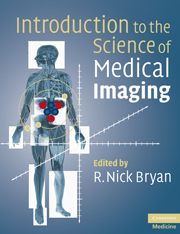17 - Molecular imaging
Published online by Cambridge University Press: 01 March 2011
Summary
Molecular imaging is the characterization, visualization, and measurement of biological processes in space and over time at the molecular and cellular level in humans and other living systems. There are two types of molecular imaging probes: naturally occurring intrinsic probes, consisting of molecules that can be visualized in the host or in isolated tissues by appropriate imaging techniques, and extrinsic probes, usually synthetic, which are introduced into the host to facilitate detection by a specific imaging technique.
A very important subclass of extrinsic probes is nanoparticles, consisting of large molecules or particles to which extrinsic imaging probes are attached for diagnosis of specific lesions or diseases. Ideally, these nanoparticles are selectively targeted to specific cells via antibodies or receptor-targeting components of the nanoparticle (e.g., the receptor-binding sequence of a lipoprotein or of a protein like transferrin). These nanoparticles may also deliver therapeutic agents, thereby facilitating a seamless transition between diagnosis and therapy. Such versatile probes, called theranostic agents, lie at the heart of the individualized diagnosis and therapy that is the goal of much current medical research.
Table 17.1 lists the various targets of molecular imaging. Except for the drugs, these targets are all intrinsic to the body. Some can be imaged directly and hence are considered intrinsic probes, but others require the addition of an extrinsic probe that binds to the target molecule and thereby makes it detectable by a molecular imaging technique.
Information
- Type
- Chapter
- Information
- Introduction to the Science of Medical Imaging , pp. 275 - 291Publisher: Cambridge University PressPrint publication year: 2009
